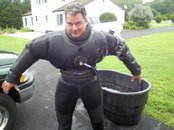- Messages
- 5,884
- Reaction score
- 2,998
- Location
- Lake Worth, Florida, United States
- # of dives
- I'm a Fish!
You seem to have some deep-rooted issues with drysuits that no DS diver I know shares with you, and I know quite a few recreational DS divers. I used to know a couple of semidry-users, but they also dive dry now.
You are of course entitled to your own opinion, so I won't try to discuss the issue any more with you. However since you're not entitled to your own facts, I want to point that you're widely exaggerating the challenges of using a DS.
I think you are misinterpreting. I think you are exaggerating the skill level/abilities of most recreational divers---which I am considering typically very poor....the agencies see this as "average". I see it as not being taught enough, to even know what you don't know
In any event, the OP was asking about ways to potentially improve SAC rate...which I have tried to do. Maybe you would like to take a shot at this , rather than being so incredibly defensive about your own gear ?





